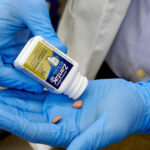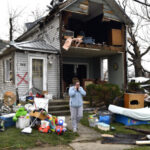Investigators are examining whether a wire smashed under a beacon battery cover caused a short- circuit that triggered a July 12 fire on a Boeing Co. 787 Dreamliner in London, a person familiar with the probe said.
U.K. and U.S. investigators are focused on the crushed wiring in the plane’s emergency locator transmitter while continuing to look into a number of possible causes for the blaze, said the person, who isn’t authorized to speak publicly.
U.S. safety regulators yesterday said they will order Dreamliner operators to check for wire damage after a beacon was linked to the fire on a parked Ethiopian Airlines Enterprise 787.
The Federal Aviation Administration is working with Chicago-based Boeing to develop instructions for the inspections, which will be made mandatory through an airworthiness directive to be issued “in the coming days,” the agency said in a statement yesterday. Operators will be told to ensure wire routing is proper, seek “any signs of wire damage or pinching” and search for heating or moisture within the devices’ battery compartment, the FAA said.
The move falls short of the U.K. Air Accidents Investigation Branch’s recommendation that the FAA direct airlines to disable the Honeywell International Inc. beacons on all 787s. The FAA said it will communicate its plan to aviation safety regulators in other countries this weekend.
FAA’s Lead
The directive would apply only to the six 787s flown by United Continental Holdings Inc. because no other U.S. carrier operates the jet. Other nations’ aviation regulators typically follow the agency’s lead, as they did in January when the FAA grounded the aircraft after lithium-ion batteries melted down in two 787s’ power systems.
“We received the recommendation from the AAIB and are working closely with Boeing and the FAA to ensure we take the appropriate action,” Christen David, a spokeswoman for Chicago- based United, said by telephone yesterday prior to the FAA’s announcement. “We have already performed visual checks on the emergency locator transmitters with no findings.”
Reuters reported earlier that investigators were looking at a pinched wire in the ELT.
Operators of the 68 Dreamliners in service have been grappling with how to respond to a July 12 blaze that scorched the composite skin of an Ethiopian Airlines’ 787, which was parked at London’s Heathrow airport with its ground power switched off. While the battery-powered beacons are self- contained in aluminum alloy casing and not integral to flight operations, they are included in the jet’s minimum equipment list, according to the FAA’s website.
Portable Beacons
Japan’s Transport Ministry will allow removal of the emergency beacons from Dreamliners and the use of portable beacons in place of the Honeywell devices, Megumi Tezuka, a spokeswoman at ANA Holdings Inc., the biggest 787 operator, said today in an e-mail. Kyodo News earlier reported the ministry’s decision.
Japanese aviation law requires emergency transmitters to be in service. An inspection of ANA’s 20-jet Dreamliner fleet didn’t uncover any issues, Nao Gunji, a spokeswoman, said earlier in a telephone interview.
The carrier had said that if the FAA had ordered the removal of the components and Boeing issued a directive, the carrier would do so once Japan’s transport ministry published a decree.
Poland’s LOT said it has made checks and the part is “fine.” U.K. charter carrier Thomson Airways removed the Honeywell locators.
Investigation Continues
U.K. regulators continue to probe whether an electrical short or other mechanism sparked the Ethiopian Airlines fire, the AAIB said on July 18. It has determined that an emergency locator transmitter powered by lithium batteries contained the only stored energy capable of starting a blaze within the area of heat damage.
The beacons are used to track downed aircraft and planes operating across oceans where there is no radar coverage. They are placed on planes for a reason, said Robert Mann, an aviation consultant based in Port Washington, New York. “These do provide a real function and safety net in real time.”
The FAA said yesterday that it does not require the transmitters to be on large commercial aircraft. The equipment can be temporarily deactivated for repairs, according to the agency’s website.
Equipment List
The device is likewise part of a minimum equipment list maintained by the European Aviation Safety Agency and can be temporarily deactivated for maintenance while the aircraft continue to fly, Richard Taylor, a spokesman for the U.K. Civil Aviation Authority, said in an e-mail.
India’s aviation safety regulator will make a decision after Air India Ltd. — which operates seven 787s — receives a directive from Boeing, Arun Mishra, director general of civil aviation, said in an earlier phone interview yesterday.
Boeing has “provided instructions to customers giving them the required information to meet their regulatory guidelines,” Marc Birtel, a Boeing spokesman said in an e-mail. “This includes either the inspection or removal of the ELT on affected airplanes, as dictated by local operational requirements.”
(With assistance from Mary Jane Credeur in Atlanta, Jennifer Surane in New York, Robert Wall in London, Chris Cooper in Tokyo and Karthikeyan Sundaram in New Delhi. Editors: Mike Millard, Kevin Miller.)
Was this article valuable?
Here are more articles you may enjoy.

 Sanofi to Pay $100 Million to Settle Zantac Cancer Lawsuits
Sanofi to Pay $100 Million to Settle Zantac Cancer Lawsuits  Gallagher: Global Insured Natural Disaster Claims Again Dominated by Severe U.S. Storms
Gallagher: Global Insured Natural Disaster Claims Again Dominated by Severe U.S. Storms  California Chiropractor Sentenced to 54 Years for $150M Workers’ Comp Scheme
California Chiropractor Sentenced to 54 Years for $150M Workers’ Comp Scheme  Report Using Aerial Imagery Keys in on Hailstorm Risks to Colorado Homes
Report Using Aerial Imagery Keys in on Hailstorm Risks to Colorado Homes 